Glide your spoon into this silky, almost mousse like, baked ricotta cheesecake. Complete with a rosewater strawberry topping and pistachio kernels for added crunch, this recipe is a guaranteed crowd pleaser.
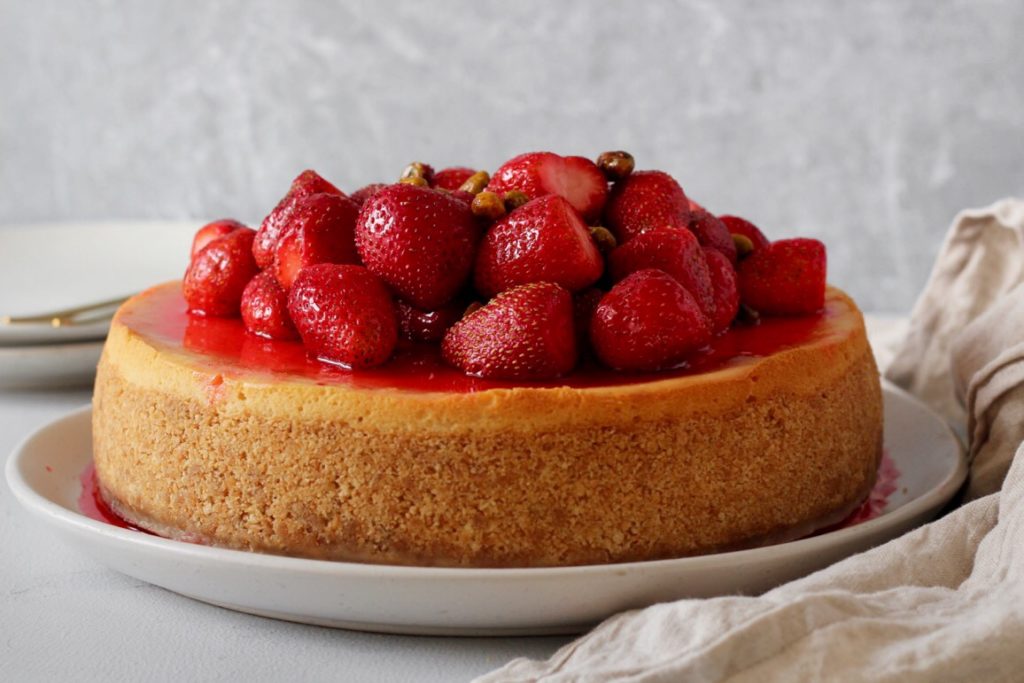
I tend to be conservative when baking. I like to bake tried and tested, classical flavours – things I know me and my small family will like. But if you’ve read the about page, you’ll know I started this blog to explore all that baking has to offer, so naturally, I’m finding myself leaving my baking comfort zone. Cue this ricotta cheesecake.
You might be puzzled, “say whaaat? Ricotta cheesecake is not extraordinary.” I would say the same, except I’ve always baked your straightforward, albeit delicious, cream cheese cheesecakes with a dusting of icing sugar and some fresh fruit to serve. This time had to be different.
I dreamed up a syrupy strawberry topping – but with my own ethnic twist, hints of rosewater and pistachios to crown a golden jewel. A few google searches later, I was toying with the idea of ricotta in my cheesecake, although it worried me: the taste, texture, integrity. Would it work? Flop? Crack? With a bit more research, some kitchen test runs, and a few taste testers to report back, my kitchen birthed the ultimate ricotta cheesecake with syrupy strawberries. It’s creamy, almost mousse like, and baked in a waterbath at a low temperature in the oven to avoid any cracking. To nail your cheesecake, read below for my top tips.
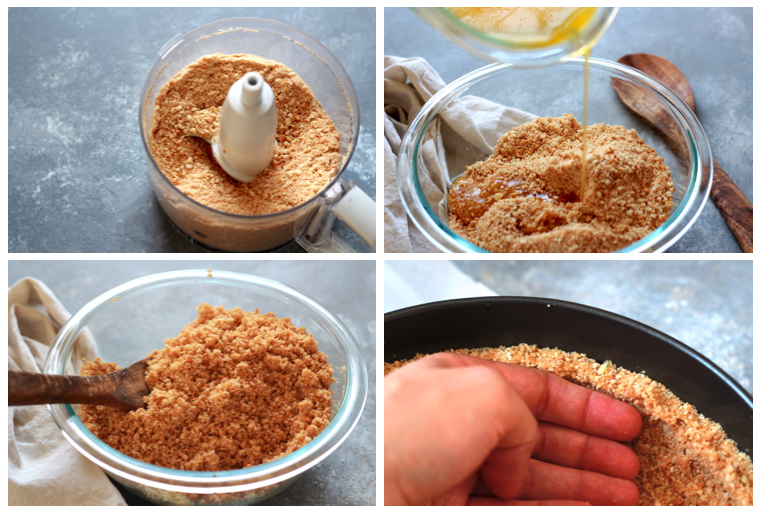
Making the perfect crust by pushing crumbs against sides of pan and pressing down on them firmly.
Why did my cheesecake crack?
There are essentially two main reasons baked cheesecakes crack. The first is overmixing the batter, and the second is overbaking the cheesecake.
-
- Overmixing the batter
Whilst you should ensure no large lumps of cream cheese or ricotta remain in your batter, it’s important not to overmix. If you keep mixing the batter once everything is well combined, you will trap air bubbles in the batter. These air bubbles cause the cheesecake to rise as it bakes. Once the cheesecake begins to cool it will fall, causing sinking and cracks. This is especially true if the sides of the cheesecake remain stuck to the sides of the pan. If on the other hand there’s a lot of trapped air in the batter, this air releases while the cheesecake bakes, causing the top to split. - Overbaking the cheesecake
Overbaking is when you bake your cake for too long or at too high a temperature. Exposing the cheesecake to high heat, or a longer than necessary baking time draws out the moisture from the batter. This drying up causes splits in the cheesecake. To overcome this, bake your cheesecake at lower oven temperatures and/or in a water bath, which helps maintain moisture. You can also consider turning off the oven before the cheesecake is fully set and let the residual heat gently finish the baking process.
- Overmixing the batter

The perfect cheesecake batter. Use raw sugar, a stevia blend, or a mix of brown and granulated sugar (see notes in recipe below).
How do I stop my cheesecake from cracking and sinking?
So now that we know why cheesecakes crack, here’s my top tips on how to avoid it happening.
- Use room temperature cream cheese to keep mixing to a minimum. Since we have to make sure no lumps remain in the batter, room temp cheese will cream quicker. This means we’re not incorporating too much air which is one the main reasons cheesecakes crack and sink.
- Add in your eggs last, making sure all other ingredients are well combined first. As eggs are the binding ingredient in a batter, they are responsible for trapping air. Once the eggs are in, mix only until well combined to keep trapped air bubbles to a minimum.
- Bake the cheesecake in a waterbath. A waterbath helps retain moisture in the cheesecake, so it doesn’t dry out and crack. If you’re worried about a leaky springform pan, wrap it well with aluminium foil. Alternatively, place a pan of boiling water on the rack below your cheesecake to help maintain oven humidity while it bakes. You may need to reduce baking temperature a few degrees if doing this.
- Avoid overbaking your cheesecake. The most common temperature to bake a cheesecake at is 180ºC / 350ºF or lower. A higher oven temperature may zap the moisture out of your cheesecake, causing it to split and sink. Make sure you follow the baking time correctly and turn off the oven as soon as your cheesecake is set. For example, if a recipe says “bake for 45 minutes to 1 hour” check the cheesecake at the 45 minute mark. Give it a slight shake, if the centre wobbles like jelly, as opposed to ripples like water, it is ready. Turn off the oven at this point and leave the door ajar.
- Allow your cheesecake to cool slowly as a dramatic shift in temperature can cause cracks. Once set, keep the cheesecake inside the oven, with the door ajar. Place on your counter about 45 minutes later and let it come to room temperature, before refrigerating.
- Run a knife around the edge of your pan to help ease it away from the sides. As a cheesecake cools it shrinks slightly. Cracks form if the edges are stuck to the pan.
- And of course, when plating the cheesecake, handle it with care. Use a spatula or a wide slotted turner to ease it off the base of your springform pan and slide it onto your serving platter.
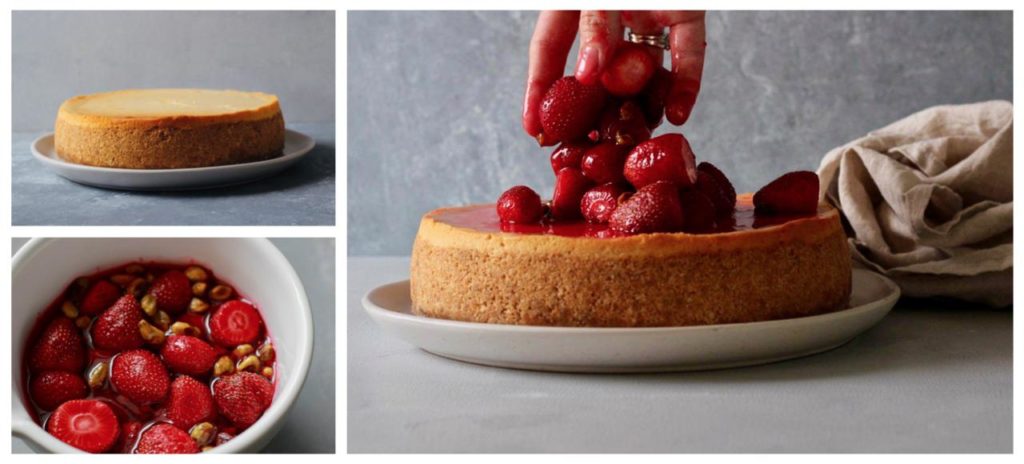
Can you freeze ricotta cheesecake?
The excellent thing about this recipe is how well it keeps before and after baking. You can prepare the ricotta cream cheese filling up to 3 days in advance, storing it in an air tight container in the coldest part of your fridge. Once ready to bake with it, give it a gentle and light mix with a spatula, pour it into the prepared crust, and bake as directed in the recipe. I recommend making the crust on the day of baking the cheesecake.
Once baked, you can freeze ricotta cheesecake. Simply follow the cooling instructions in the recipe below, then wrap well with cling wrap (a double layer to ensure no freezer burn occurs). Cover with foil, place in a bag or air tight container and freeze for up to one month. Do not freeze with the strawberry topping as it will become soggy once defrosted. Make the strawberry topping on the day you wish to serve the cheesecake.
To defrost the ricotta cheesecake, simply place in the fridge overnight to thaw, then let stand at room temperature for 30 minutes prior to serving.
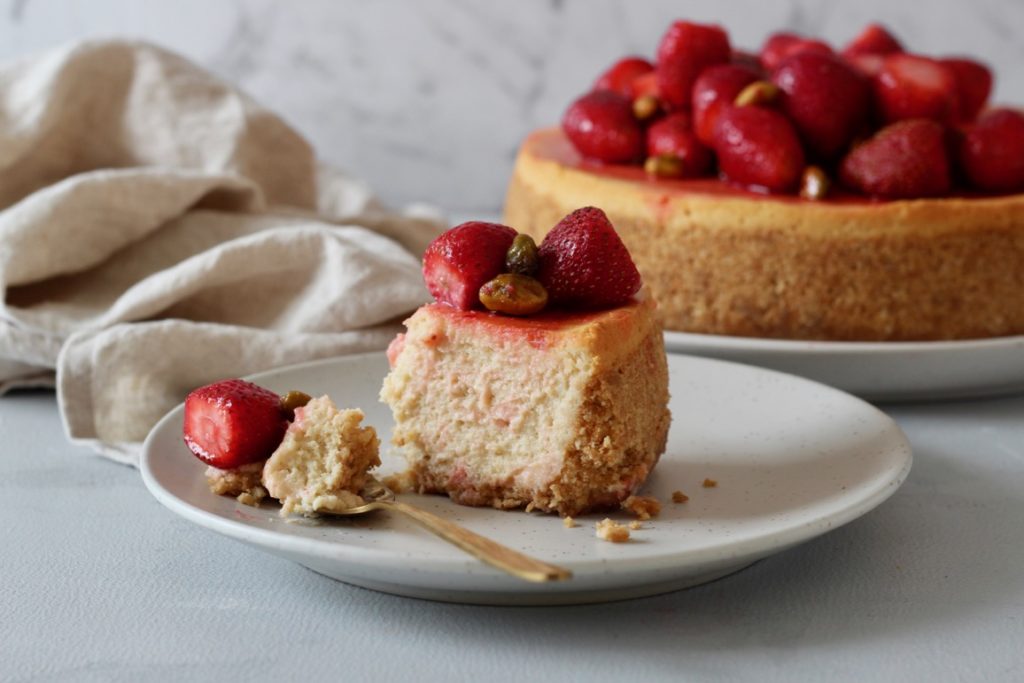

Ricotta Cheesecake with Rosewater Syrupy Strawberries
Ingredients
Cheesecake Filling
- 375 grams (1 1/2 packs) cream cheese, softened to room temperature
- 1 cup (250g) ricotta cheese
- 1 cup raw sugar, see notes below
- 1 tsp vanilla
- 1 tbsp lemon juice, about half a lemon
- 2 tbsp plain flour, (can be subbed with cornflour)
- 2 large eggs, lightly whisked
Biscuit Base
- 32 (approx 190g) plain tea biscuits, (see notes below)
- 125 grams butter, melted
Rosewater Syrupy Strawberries
- ¼ cup granulated sugar
- ⅛ cup water
- 2 ½ cups fresh strawberries, stems and leaves removed, divided
- 1 tsp rosewater (optional), sub with vanilla
- ⅛ cup pistachio kernels
Instructions
- Preheat oven to 180 C / 350 F / 160 C fan forced.Line the base of a springform pan with parchment paper, allowing several centimetres overhang, and attach the side.
- Place tea biscuits into the bowl of a food processor and pulse until biscuits resemble rough crumbs. Through the food processor's chute, pour melted butter while running the processor on lowest speed, until crumbs are fine and wet with butter.Alternatively, place biscuits in a ziplock bag and crush with a rolling pin to fine crumbs. Pour crumbs into a mixing bowl and stir in melted butter with a wooden spoon until all the crumbs are wet.The crumbs should keep together when pressed, if they seem loose add an extra tablespoon of melted butter.
- Transfer the crumb mixture to the springform pan. Press into the base and sides to evenly distribute. Bake for about 12 minutes until lightly toasted and golden. Set aside.
- To make the cheesecake, beat cream cheese and ricotta on low speed in a large bowl, or in the bowl of a stand mixer. Add sugar, vanilla, lemon juice and flour. Add eggs, one at a time, allowing each to incorporate before adding the next. Remember to scrape down the sides of the bowl often.
- Pour cheesecake batter over the base and place springform pan in a roasting dish. Fill roasting dish with boiling water, about half way up the springform pan to create a water bath.
- Bake for 1 hour 15 minutes, or until the top is golden and the centre wobbles like jelly, as opposed to ripples like water.Turn off the oven and leave door ajar. Let cheesecake cool in the oven for 30-45minutes. Remove from roasting tray and set on a cooling rack for another hour to bring to room temperature. Cover and refrigerate for 4-6 hours, or overnight to completely set.
- To make the strawberry glaze, add 1/2 cup of fresh strawberries, water, sugar and rosewater (or vanilla) into a small saucepan. Lightly mash the strawberries in the saucepan using the back of a wooden spoon. Let simmer on low heat for 10-15 minutes until slightly thickened. Turn off stove and set aside for 10 minutes, then gently mix in remaining strawberries and pistachios. Set aside to cool slightly, or until ready to serve cheesecake.
- To serve, remove cheesecake from springform pan and slide off the parchment paper onto serving platter, using an offset spatula if required.Top with syrup-soaked strawberries and pistachios, adding some of the syrup as desired.Cut into 8-10 slices and serve.
Notes
Tried it? Let me know if you liked it!
Go on and rate the recipe in the comments below. And don’t forget to tag your creations on Instagram with @tilgoldenbrown #tilgoldenbrown so I can feature them! 
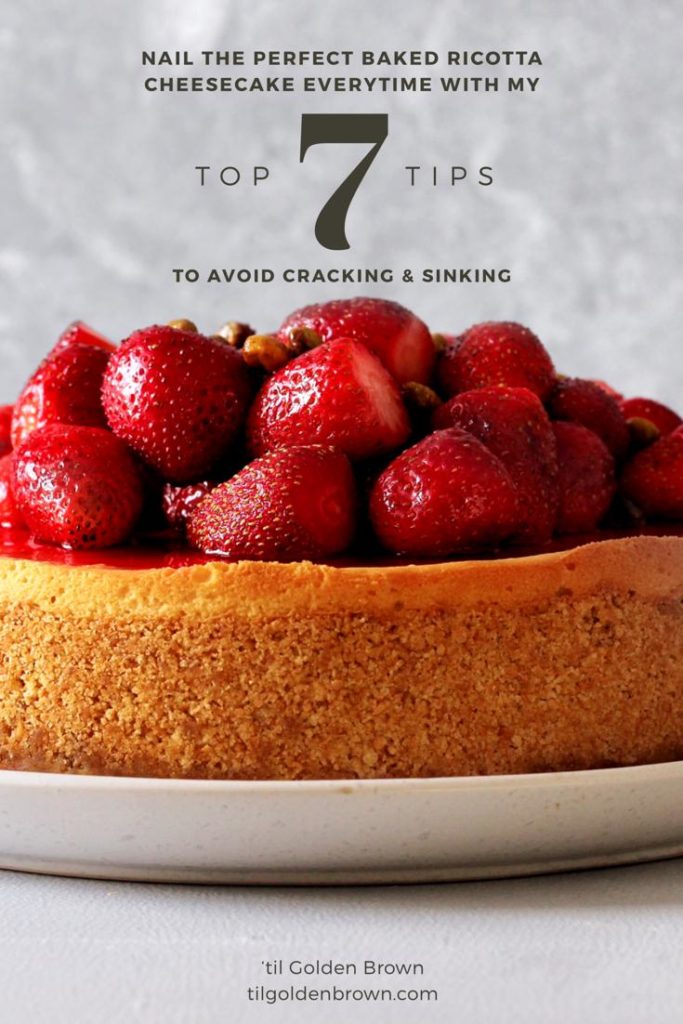
Your cheesecake shot looks amazing!!
Thank you! ❤️